At first glance, the catchphrase of Monty Python’s Flying Circus “And now for something completely different,” would sum up 2017 NASCAR. As the season played out, however, it went from “something completely different” to a return to form.
Monster Energy and NASCAR are as polar opposite as it gets. The former is an energy drink brand that understands how to target the youth of the United States, while the latter — despite its many attempts to appeal to a younger audience the last decade — is still dependent on an ever-aging demographic of Baby Boomers.
Compounding the matter, 2016 was the 10th-year of a decade-long slide in television ratings. And as much as the big whigs in Daytona won’t admit it, something had to change.
So on January 23, it would’ve been so fitting if NASCAR unveiled their 2017 changes — oh sorry, “enhancements” — via a segue from this.
The idea of throwing out the caution two predetermined points to break up the, at times, roughly three-hour marathon events into more digestible segments (or stages) not only was “something completely different,” but it reeked of desperation.
But that wasn’t all. To quote a mediocre comedy…
Whether or not you called in the next 15 minutes, NASCAR doubled the offer with stage points and playoff points for no extra charge.
The funny thing is that while these “enhancements” offended me as a racing purist, I wanted to see where they led NASCAR. Especially the playoff points, which answered the prayers of us who wanted consistency and the regular season to matter again.
So with a new title sponsor — one which, as of the publishing of this column, has yet to exercise its option to stay past the end of 2018 (SB Nation) — that appeals to millennials, a radically new approach on racing, points that carry through the entire playoffs and an aforementioned decade-long TV ratings slump, to say 2017 would be a make or break season would be an understatement. And NASCAR needed to knock it out of the park with opening day.
So the first race of the 2017 Monster Energy NASCAR Cup Series season arrived, as it always does, at Daytona International Speedway on February 26 with the 59th running of the Daytona 500. The stages came and went, with Kevin Harvick and Kyle Busch winning them, and a whole mess of cars were swept up in multi-car wrecks (it’s Daytona).
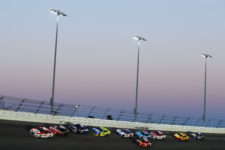
The final laps of the 59th Daytona 500 was beautiful restrictor plate racing. There was intense fighting for the lead and position, whether it was in a pack or in single-file, fuel strategy with varying results through the lead pack and a last lap pass for the win.
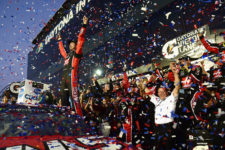
And to top it off, Kurt Busch — who only two days prior to the 2015 Daytona 500, was indefinitely suspended by NASCAR over allegations of domestic abuse — stood on top of the NASCAR world as champion of the sport’s biggest race.
So did February 26, 2017 give NASCAR the monumental start it needed in this “something completely different” season? The jury is still deliberating on that. I think we’ll know for sure at the end of the 2018 season, especially since Monster Energy will either continue or end its relationship with NASCAR.
It’s one thing for NASCAR’s restrictor plate package to deliver, but did the one for the intermediate tracks…
Yeah, I couldn’t finish that sentence with a straight face.
Now I’ve told this story before. But for those who don’t know, while standing on pit road, Jeff Gluck and I traded thoughts about the Folds of Honor QuikTrip 500, after the race, at Atlanta Motor Speedway. I told him “I thought the race was okay for Atlanta, and that was with the way it ended, with Kevin Harvick’s speeding penalty. Take that out of the equation and Harvick wins it, I don’t think it registers.”
“Oh agreed,” Gluck said. “It’s basically (Martin) Truex (Jr.) at Charlotte if Harvick wins.”
And that sums up the 2017 Cup race at Atlanta: Harvick dominates, but blows it for the fourth straight year.
If I may peel back the curtain, this is an outcome sportswriters — especially those on deadline — hate. While we as writers “root for the best ‘stories,'” clinic performances like Harvick at Atlanta that end with said dominant driver winning on a long day — this race was three hours, 33 minutes and eight seconds — make the writing process that follows easier. When that dominate driver blows it, we got to start all over again.
For example: Deciding not to trust my cynical instincts as the laps wound down, I wrote up a race report in which Harvick ended his run of bad luck at Atlanta. All it needed was quotes, statistics and a photo, and it would’ve been published within 45 minutes of Harvick winning.
And then he was busted for speeding on pit road. He finished ninth.
So my short evening of writing turned into a two and a half-hour evening (I didn’t get back to Knoxville until midnight).
I also told Gluck that “the intensity was nowhere near as high as it was last week at Daytona. Now I know Daytona is its own animal, but the stages and points cranked it up to 11. So after the Daytona 500, I was thinking, ‘Oh my God. NASCAR has struck gold with this! If this is what we’re gonna get every week, the sport will be on top of the world!’ But about halfway through it, after watching it unfold from the press box, I’m just thinking, ‘Oh…*sigh.* This isn’t going to be a weekly thing. This is just the same old downforce racing we see every week.'”
And…I was right. Week after week, we got the same old tired downforce-centric racing that’s made the mile and a half races unbearable.
It wasn’t until the short track gauntlet that we got a string of decent races, with Martinsville Speedway, Bristol Motor Speedway, Richmond Raceway and Talladega Superspeedway (and I know Talladega isn’t a short track, but it was part of that string of great races).
But at Richmond in April, “encumberment” struck race winner Joey Logano. While NASCAR let the win stand, he couldn’t use the benefits of that win to qualify for the playoffs. Since he didn’t win another race, Logano — a preseason favorite to win the title — missed the playoffs. At some point, I’ll write a column with my thoughts on “encumbered” wins. But it boils down to this: Why is an “encumbered” win bad enough that a driver can’t use the benefits of it to qualify for the playoffs, but not enough to strike it from the NASCAR record?
Switching gears, let’s discuss the run of first-time winners in a five-race span.
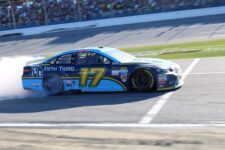
Talladega was the start of a five-race stretch in which three drivers scored their first career Monster Energy NASCAR Cup Series victory.
Days like Ricky Stenhouse Jr., Austin Dillon and Ryan Blaney celebrating in victory lane for the first time almost make me wish I wasn’t so cynical. Watching on TV Dillon play the fuel game right to win the Coca-Cola 600 and Blaney just out-race Kyle Busch and hold of Kevin Harvick to win at Pocono Raceway was awesome. But it was nothing compared to seeing it happen in person, as I did when Stenhouse passed Busch on the final lap to win at Talladega.
By the summer stretch, Kyle Larson and Martin Truex Jr. established themselves as the dominant drivers. Larson took the points lead in NASCAR’s first trip to Phoenix and held it until the Coca-Cola 600. Truex led for the next three races, was usurped by Larson for three, retook it lead after his clinic performance at Kentucky and didn’t relinquish it the rest of the season.
Truex didn’t win the title uncontested, however, as Joe Gibbs Racing challenged his supremacy. Spearheading it was Kyle Busch, who with a strong drive and victory at Pocono and complete weekend sweep at Bristol put himself in position to steal the title from Truex.
While the fight for the drivers title was hotly contested, nobody questioned who the dominant manufacturer was.
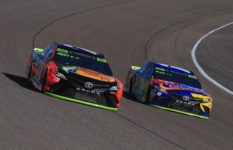
In the first half of the season, there was a greater level of parity amongst the manufacturers (in terms of wins). But in the second half, the Toyota camp was all but unstoppable, winning 13 of the final 18 races. Chevrolet’s only real bullet in the gun was Larson, but an engine failure in the cutoff race of the Round of 12 ended any realistic possibility of another championship for the bow tie’s. Ford remained in the hunt for a title with their dominance of restrictor plate racing, Kevin Harvick running down and passing Truex in the closing laps at Texas Motor Speedway and Brad Keselowski benefiting from the misfortune of others to race Kyle Busch and Truex for the title at Homestead-Miami Speedway.
Unfortunately for Harvick and Keselowski, while never too far from the front, they were no match for the Toyota’s on the mile and a half Homestead.
Only Larson posed a threat to either Busch or Truex, leading 145 of 267 laps. But with 105 laps to go, the race — and championship — was down to just Truex and Busch.
While Truex pitted with 69 to go, Busch stayed out until 50 to go, putting him within the fuel window to make the finish. His one-stop strategy went wayside when Kurt Busch spun out, scattering debris on the track, with 39 to go.
A few laps after the restart with 34 to go, Busch was held up trying to pass Joey Logano for third. While he passed Harvick for second with ease, he didn’t have “enough tire” when he caught Truex.
“Yeah, it wasn’t quite what we wanted there at the end,” Busch said. “I thought we had a really great race car, especially on the long runs. We were really, really good. Just came down to there at the end not having enough tire when I got to the 78 (Truex), so I just overused my stuff, and I knew I overused my stuff when I was running with the 22 (Logano) trying to get by him and just overworked everything and got to the 4 (Harvick), got by him pretty quick, I tried to make sure that I could do that pretty quick so then I could have at least a little more tire life, but didn’t seem to pay me off any when I got to the 78.”
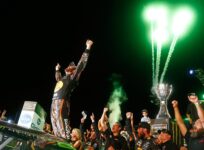
When the checkered flag waved, Martin Truex Jr. — who four years prior, after finding himself out of a ride due to the actions of others at Michael Waltrip Racing, sat on his front porch thinking his career was over — was no longer a journeyman who won only three times in an eight-year span, racing for the little team in Denver. At that moment he was, and forever will be, a Monster Energy NASCAR Cup Series champion.
“It’s overwhelming,” Truex said. “You think about all the rough days, the bad days, the days that we couldn’t run 20th to be here. I never thought this day would come and to be here is unbelievable!
“I can’t believe it. I’ve wanted it since I was a little kid. Just never give up. Just never give up on your dreams, no matter what happens, or what kind of crap you go through.”
The races of the 2017 Monster Energy NASCAR Cup Series season were very hit and miss, but it was NASCAR at its best. Playoff points made performance in the regular season matter again. And that they carried through the whole playoffs made the whole season the closest we’ll get back to a season-long points format. Stage points, as much as I hate them, put more emphasis not on saving your stuff until the end, but on running up front all day/night long. Yes, x-factors such as luck and bullshit still factor into the playoffs, but not to the degree of the last three years. Take the playoffs out of the equation, this would most likely remain the outcome (although Harvick and Keselowski probably would’ve been out of the hunt by Homestead in a season-long format).
And that’s what this season had over the last three. It was the closest thing to a naturally played-out one that’s possible with NASCAR. Unlike 2014 through 2016, I didn’t feel empty with how the course of the season brought us to this outcome.
Let’s hope we have another season like this, or better, in 2018.
That’s my view for what it’s worth.







